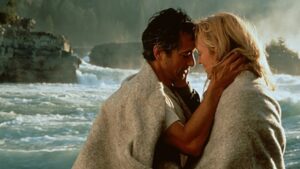THE VISUAL WORLD 3
PART 3

THE WORLD OF THE RIVER
Rivers are roads in or roads out. They are places of passage and symbolize a
journey. One never knows what is behind the next bend. It could be calm
clear waters or churning treacherous rapids. Friends and foes appear
unexpectedly along the way. Sometimes it’s hard to know which is which.
DELIVERANCE and THE RIVER WILD both depict the dangers of a river
journey.
Navigating the river requires hard work and but also allows time for floating
free. The river world is a place of rhythm and flow. The object here is the
journey rather than the destination.
THE WORLD OF HOUSE AND HOME
House and home is the first world we know as children. Home is the center
of our universe. It is the central space of human drama. Everything we
know about love we learn here first. Everything we know about conflict and
violence we first discover here.
There are two kinds of houses—warm and cold. A warm house is a place
of happy memories. It is a nostalgic place, a place where we are accepted
and loved. A warm house is bright and happy. The glowing kitchen is the
heart of this kind of home. It is open and friendly.
The cold house is often a trap or prison. It can be a place of cruelty and of horror.
This is a house where terrible secrets are kept and/or where its inhabitants are
hunted or haunted. The cold house is dark and dreary. It is a closed and often
claustrophobic place.
Inside the house certain spaces have deeper meanings and symbolic
significance.
The attic is a place of the past. It is a place where valuables and unexpected
treasure is hidden. The attic is a repository of memories and old keepsakes.
It can also be a place where we leave our past behind and struggle toward
the future. Artist and writers often create in attic or garret spaces. The attic
is a place of make-believe and imagination. It can also be a place of
madness—where family secrets are hidden or locked away.
The cellar is a place where things are buried. Cellars are dark, dank, scary
places. They are often where monsters lurk. A cellar is often is a place of
ugly secrets, torture and/or darkness.
THE HAUNTING OF HILL HOUSE is the ultimate cold house horror movie.
THE FABLEMANS is a warm house movie filled with love and eccentricity but
no small amount of tension and conflict.
COMBINED WORLDS
The most powerful worlds can be combinations. For example: The city can
be depicted as a jungle—a place of rot and decay where men hunt and kill
each other. Or it can be depicted as the ocean surface—the rooftops maybe
placid but below lurk all kinds of conflict, turmoil and danger waiting to trap
or devour us.
The city can be viewed as an island, as Manhattan physically is.
The island/city is a place both magical and nightmarish. Cities can be
depicted as a mountain world. A city might be a vertical place of majestic
heights where the mighty look down on the lowly. This is a place where
rich stronghold tower above the poverty and oppression below. The city
might also be a small dot on the open plains where civilization is purchased
at the expense of freedom and wide-open spaces.


THE SEASONS
Summer is a time of equilibrium. It is a time of utopia—it is always summer
in Camelot. Summer is a lush time. It is a time of beauty and golden
sunlight. Summertime is when “the living is easy.”
Autumn is a time of harvest—when crops are gathered into the barn as stores
against the coming of winter. It is a time of waning days and fading
sunlight. Autumn often is the time when the hero falls. It is when opponents
often attack. Autumn usually signals the end of things—when the best days
are behind us, and only bleakness lies ahead.
Winter is the lowest time of the year. In winter, the hero is closest to death.
Winter is an arid, frozen time. All hope is lost. The world seems dark, and
everything hovers on the edge of extinction.
Spring is the time when hope is reborn. In spring, we shed our skin and begin
life anew. A new equilibrium is achieved. A new order is restored. The hero
rises again or is reborn at some higher level. Spring is the time of
resurrection and the renewal of all things.
Anti-seasonal structures can often be used to create dynamic opposites by
contrasting traditional cycles with the dramatic developments in the story.
For example—marriage in winter (what does this mean—are the darkest
days behind us?) Perhaps the hero falls at the height of summer (is he
destroyed at the height of his powers and waiting to be reborn when he can
turn his greatest weakness into his greatest strength?) Playing against
seasonal cycles offers a rich and potent way to depict the emotional
undercurrents in the story.
Use the visual world to deepen and enhance your story and short-hand its
underlying themes. Cue the audience as to how your protagonist “sees” his/her
world and him/herself and use the visual world to express the protagonist’s
emotional state. The visual world should be as unique as the protagonist
him/herself.




Create a visual map for a character’s emotional journey. Pull stories from character rather from rote story structure beats. Some of the largest international media companies, use this in story and character development.


A clear concise guide for writers and producers to have by their side as they embark on a project. It gives a really vital reminder of what is key for story success.

No comment yet, add your voice below!